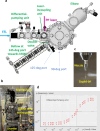The Heisenberg-RIXS instrument at the European XFEL
- PMID: 39705248
- PMCID: PMC11708868
- DOI: 10.1107/S1600577524010890
The Heisenberg-RIXS instrument at the European XFEL
Abstract
Resonant inelastic X-ray scattering (RIXS) is an ideal X-ray spectroscopy method to push the combination of energy and time resolutions to the Fourier transform ultimate limit, because it is unaffected by the core-hole lifetime energy broadening. Also, in pump-probe experiments the interaction time is made very short by the same core-hole lifetime. RIXS is very photon hungry so it takes great advantage from high-repetition-rate pulsed X-ray sources like the European XFEL. The Heisenberg RIXS instrument is designed for RIXS experiments in the soft X-ray range with energy resolution approaching the Fourier and the Heisenberg limits. It is based on a spherical grating with variable line spacing and a position-sensitive 2D detector. Initially, two gratings were installed to adequately cover the whole photon energy range. With optimized spot size on the sample and small pixel detector the energy resolution can be better than 40 meV (90 meV) at any photon energy below 1000 eV with the high-resolution (high-transmission) grating. At the SCS instrument of the European XFEL the spectrometer can be easily positioned thanks to air pads on a high-quality floor, allowing the scattering angle to be continuously adjusted over the 65-145° range. It can be coupled to two different sample interaction chambers, one for liquid jets and one for solids, each state-of-the-art equipped and compatible for optical laser pumping in collinear geometry. The measured performances, in terms of energy resolution and count rate on the detector, closely match design expectations. The Heisenberg RIXS instrument has been open to public users since the summer of 2022.
Keywords: European XFEL; Heisenberg RIXS; RIXS; X-ray Raman scattering; X-ray resonant diffraction; charge order; free-electron lasers; hRIXS; photochemistry; resonant X-ray diffraction; resonant inelastic X-ray scattering; soft X-rays; spin dynamics; spin order; time-resolved spectroscopy.
open access.
Figures












References
-
- Aharonov, Y. & Bohm, D. (1961). Phys. Rev.122, 1649–1658.
-
- Ament, L. J., Ghiringhelli, G., Sala, M. M., Braicovich, L. & van den Brink, J. (2009). Phys. Rev. Lett.103, 117003. - PubMed
-
- Ament, L. J., van Veenendaal, M., Devereaux, T. P., Hill, J. P. & van den Brink, J. (2011). Rev. Mod. Phys.83, 705–767.
-
- Amorese, A., Langini, C., Dellea, G., Kummer, K., Brookes, N., Braicovich, L. & Ghiringhelli, G. (2019). Nucl. Instrum. Methods Phys. Res. A, 935, 222–226.
-
- Arpaia, R., Caprara, S., Fumagalli, R., De Vecchi, G., Peng, Y., Andersson, E., Betto, D., De Luca, G., Brookes, N., Lombardi, F., Salluzzo, M., Braicovich, L., Di Castro, C., Grilli, M. & Ghiringhelli, G. (2019). Science, 365, 906–910. - PubMed
Grants and funding
LinkOut - more resources
Full Text Sources

